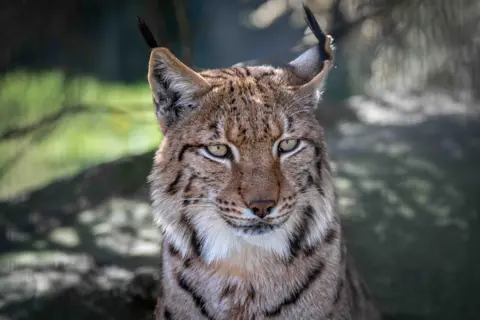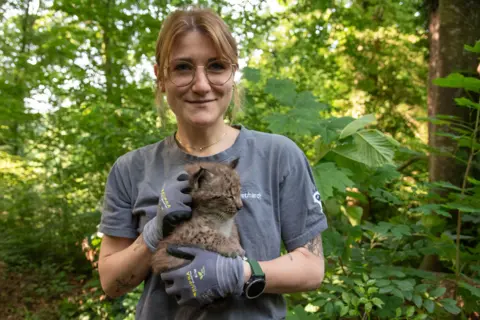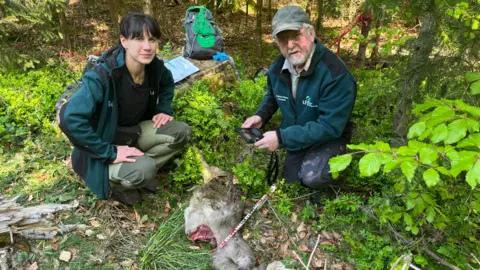BBC environment correspondent
A lynx from a Cornish zoo may become the first zoo-born cat in the UK to be released back into the wild.
Generally, animals raised in captivity aren’t released due to a lack of survival skills or excessive human habituation.
However, a shortage of female lynxes in the European breeding program prompted an unusual request for the cat from Newquay Zoo.
The lynx has been relocated to the Black Forest in Germany for a few months of observation in a controlled environment to evaluate its adaptability.

Tony Jolliffe/BBC
This week, BBC witnessed the careful loading of the Newquay lynx onto a lorry destined for southwestern Germany, aided by gentle nudges with a broom.
Two days later, we were in Germany as it was coaxed into a 1,200-square-meter enclosure. John Meek from Newquay Zoo observed the lynx cautiously step out into its new environment.
“I’m a big boy, but I had tears in my eyes,” he shared. “Zoos today focus on conservation, and this is a prime example of that.”
While thousands of lynxes roam wild in Europe, there is an ongoing effort to introduce new individuals to enhance genetic diversity, particularly in central Europe.
Although not officially categorized as “big cats,” Eurasian lynxes can weigh up to 30 kilos and successfully hunt deer.
Having once thrived in the UK, lynxes were driven to extinction centuries ago; with deer populations now soaring, there are renewed calls for their reintroduction.

Dina Gebhardt/Bern Animal Park
“You could say I’m like Tinder for captive lynxes,” explains Dina Gebhardt, who coordinated the Newquay lynx’s relocation, during our Zoom interview.
As the lynx-breeding coordinator for the European Endangered Species Programme (EEP), she pairs female and male lynxes and seeks new homes for their young.
“Our natural habitats are fragmented due to urban development, leading to barriers that cause inbreeding,” Dina notes.
To address this issue, she sources young lynxes from captivity for release to help boost populations and enhance genetic diversity. Typically, these lynxes are raised with minimal human interaction to prepare them for reintroduction.
Last year, however, she faced the challenge of an unusual surplus of male lynxes, which complicates successful rewilding efforts that require females.
Thus, she reached out to Newquay Zoo, inquiring about their one-year-old female lynx.
“We were eager to participate,” said John Meek, Newquay Zoo’s curator of plants and animals.

Jonah Fisher/BBC
The lynx will be closely observed over the coming months to determine its survival capabilities. Catching prey isn’t anticipated to pose a challenge.
“Even a cat raised indoors can instinctively hunt once it gets outside,” says Eva Klebelsberg, who oversees the lynx reintroduction program for Baden-Württemberg.
We stood over the carcass of a roe deer in the Black Forest, just outside Karlsruhe, a known hunting territory for the local lynx population.
Puncture marks on the throat confirmed this was a lynx’s kill.
“Europe’s ecosystems lack large predators,” Eva explains, noting how lynxes help manage deer populations and prevent them from overgrazing forested areas.
The crucial aspect regarding the Newquay lynx will be its interactions with humans. Having lived behind bars and reliant on keepers, the lynx must demonstrate an aversion to human contact.
“Central Europe is densely populated, leaving little room for larger wildlife,” comments Dr. Marco Roller from Karlsruhe Zoo, who is in charge of the enclosure.
“We aim to avoid human-wildlife conflicts, so it’s critical we have neither overly aggressive nor overly curious animals venturing into towns or near human habitats.”
A final assessment of the Newquay lynx will be made later this summer after thorough monitoring.


